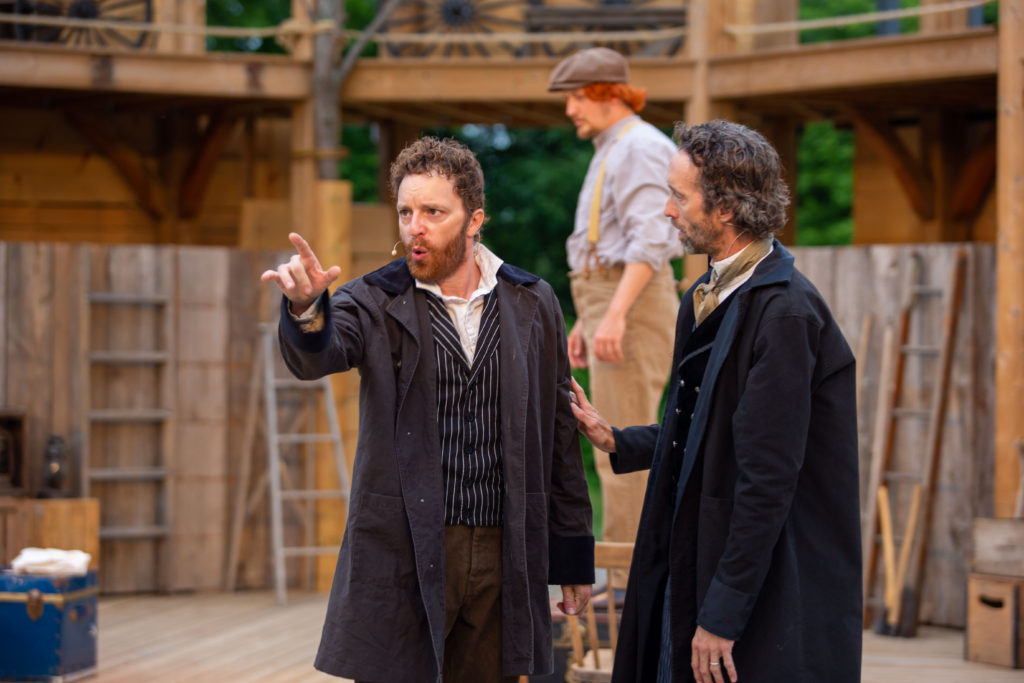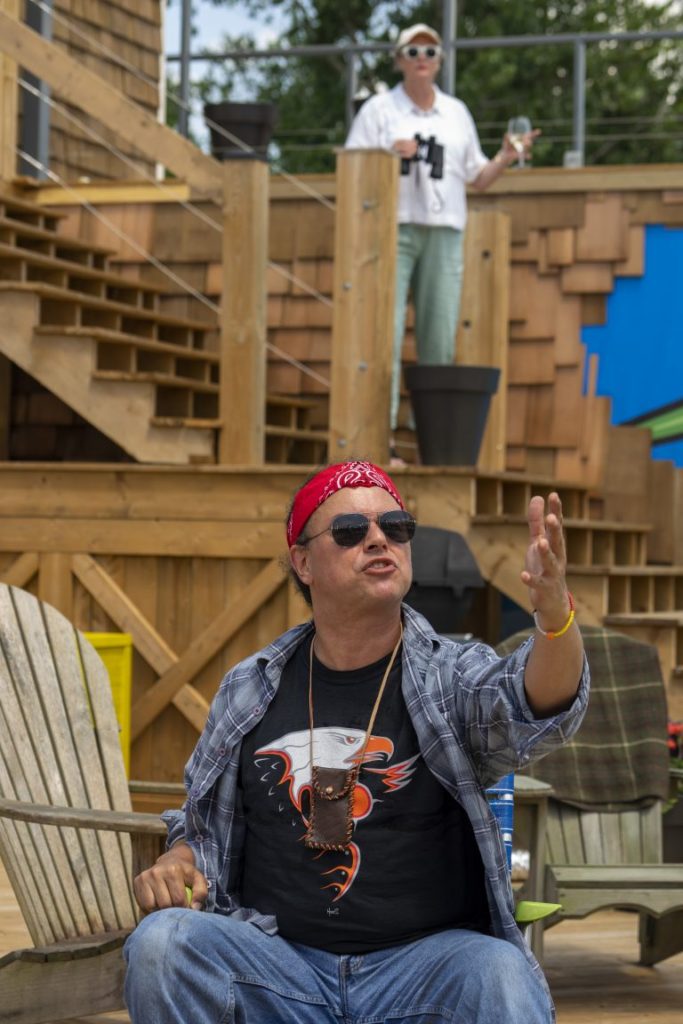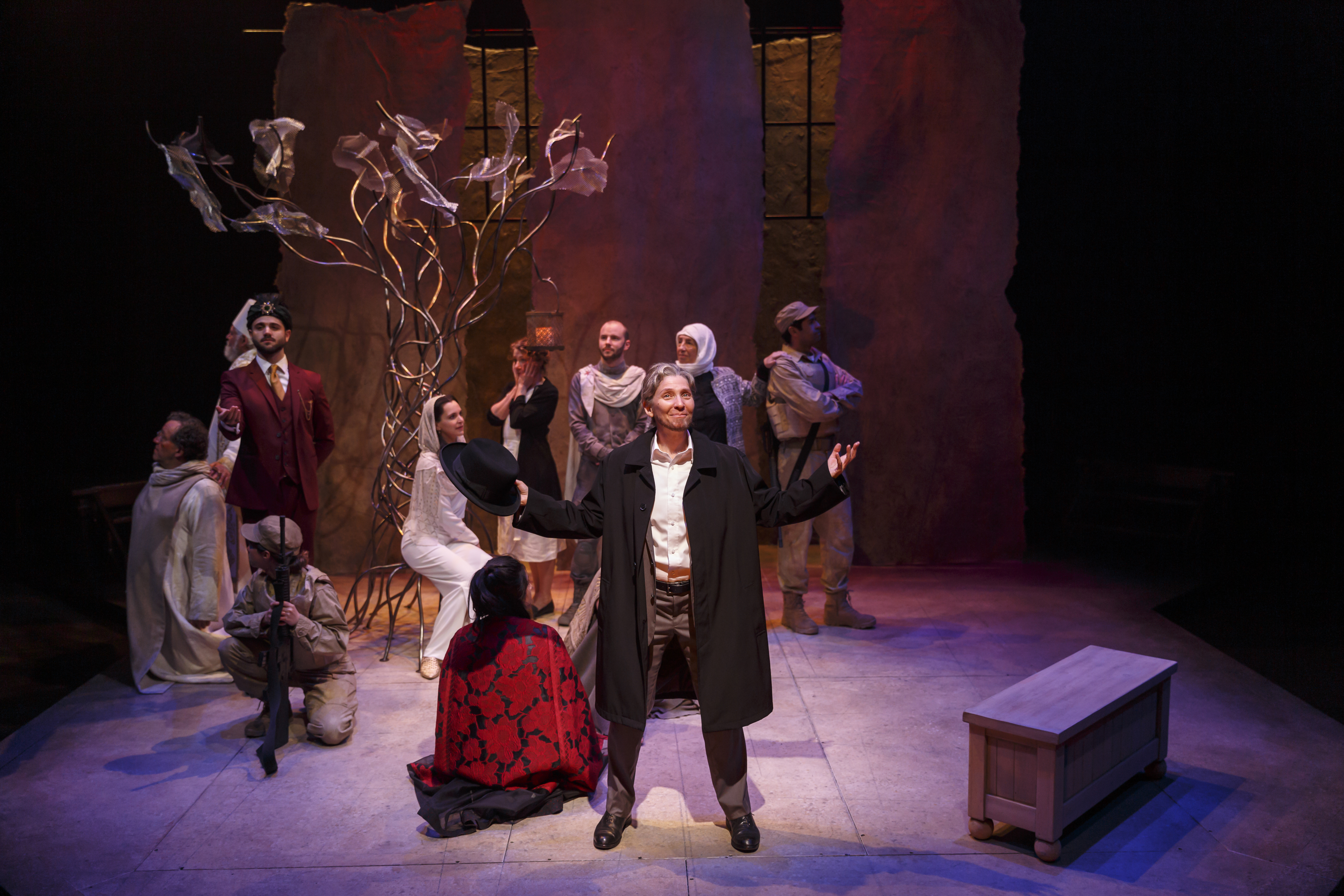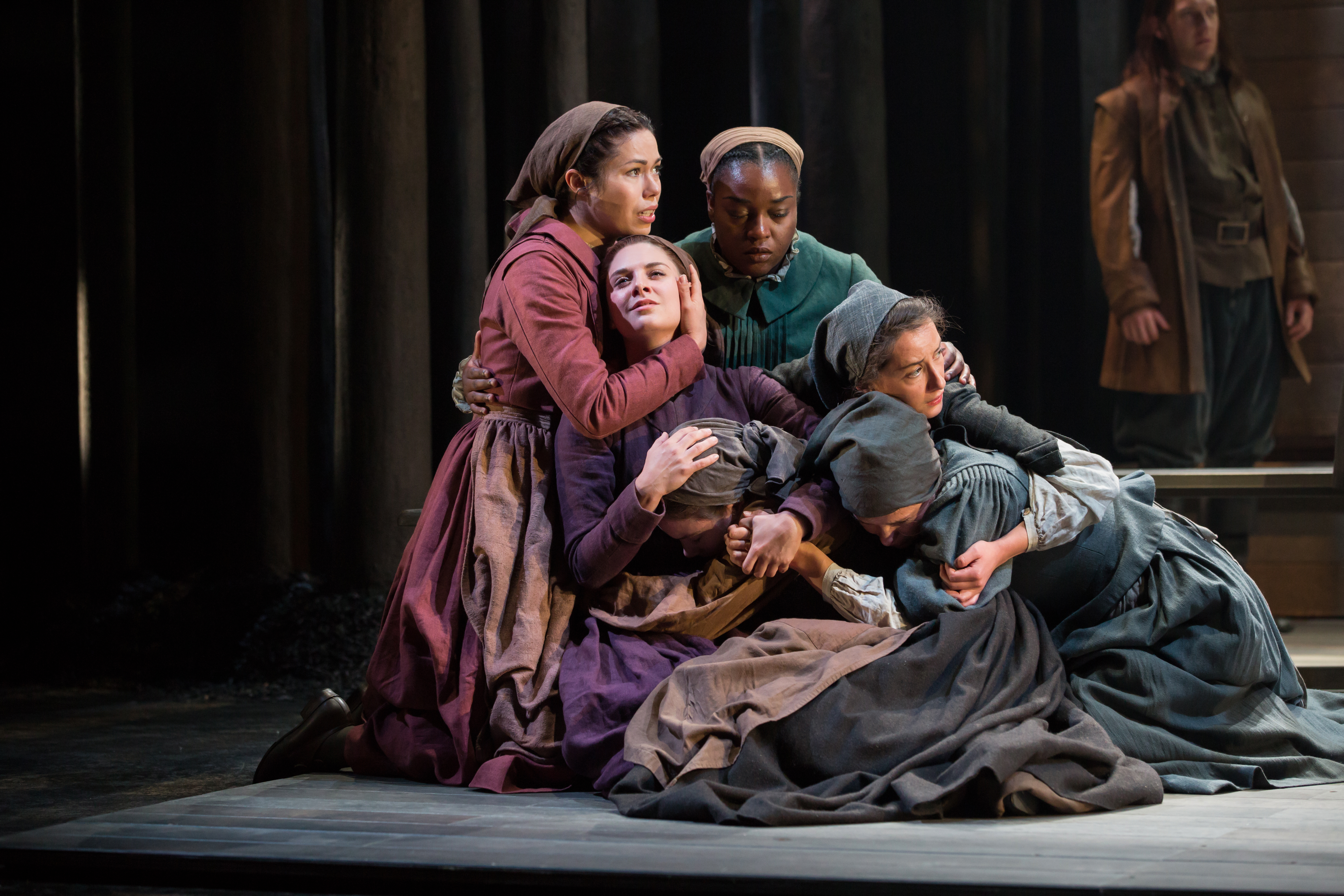James Reaney’s The Donnellys trilogy and the Making of the Canadian Nation.
The Donnellys: A Trilogy. Blyth Festival Theatre. June 22-Sept. 3, 2023
The Black Donnellys ride
Their killers by their side
Down the Roman Line till the end of time
Stompin’ Tom Connors

When you head out of London on Highway 4 North, it is almost a straight line through to Lucan, and easy to imagine the relative ease of the journey by stagecoach in the years before, first, the railway and then the automobile. The land is mostly flat, with farmland stretching for miles on each side of the road. In winter, there is always the risk of a snow squall, but in summer, the blue sky and the variegated green corn fields almost meet, with only the thinnest painterly line to divide them.
The half-hour drive to the Roman Line takes you to St. Patrick’s church and the cemetery where the Irish-Catholic Donnellys, who first came out of Tipperary in 1840 to settle in Biddulph County in Upper Canada, are buried. Part history and part detective story, the brutal massacre of five members of the family by an armed vigilante mob of their neighbors on February 3, 1880, took place in what many contemporaries called “the most lawless county in the country”.
The legend lives on, not only in the Lucan Area Heritage and Donnelly Museum but also a Donnelly café, where you can hear locals taking sides (the villains like life-size cardboard cutouts of long-gone but still familiar miscreants) while you grab a very up-to-the-minute latte, the new menu shaped by the creeping signs of gentrification in what was once a sleepy town.
James Reaney saw his own foraging in documents to get to the “truth” behind the myth as a return to that part of South Western Ontario where he grew up on a farm just outside of Stratford. Throughout an astonishingly diverse body of work that included poetry, theatre, opera, and children’s plays and stories, he carved out his own literary territory (Souwesto) as both real and literary space, like Faulkner’s legendary Yoknapatawpha county. The ambitious and celebrated trilogy that emerged from his Donnelly research firmly established the plays as rooted in a particular time and place, powerful regional drama. A logical enough taxonomy in the early days of creating a fledgling home-grown Canadian literary tradition – but maybe one also long overdue for rethinking.
What if we got this earlier naming wrong, limiting the centrality of the Donnellys trilogy’s place in the deeper forging of the new Canadian union – burrowing deep into themes that are not merely local and regional, but at the very heart of the making of nation?
This would mean that Reaney’s Donnellys trilogy is not just a hugely accomplished landmark in Canadian theatre (think combining the two separate Naturalist and Symbolist strands of the famed Nationalist Irish Abbey Theatre in Dublin), but something much more remarkable. A three-part drama that performs the always at-risk dream of making a whole of quarreling parts. In one frozen moment of time, one grisly family murder was raised to the status of national history as a myth.
The ambitious mounting of the Donnellys trilogy in its entirety at the Blyth Festival Theatre has to be seen as one of the major events of the 2023 theatre season. Under the talented and energetic direction of Gil Garratt, Blyth has maintained and grown its reputation as the little theatre that could. In almost every way that counts, the Blyth Festival Theatre in tiny Blyth (pop. 1,065) resembles the 1939 children’s fable about the train that overcomes its size through dogged optimism and hard work (“I think I can. I know I can.”) to stage an often original and daring Canadian repertoire that larger and considerably better funded Canadian theatres shy away from- and it does so with remarkably high-performance values.
The first play in the trilogy, Sticks and Stones (The plays opened gradually throughout the season which turned the summer months into an ongoing “event”) introduces us to all the characters as well as the spatial geographies that determine the plays’ antagonists. The title is both material and metaphorical, the name-calling, that, despite the moral of the children’s rhyme, can break your bones.
Central to Reaney’s position in the Donnellys’ debate is the continuance of the old country Irish-Catholic feud between the Whitefeet and the Blackfeet, a reading at the heart of Orlo Miller’s 1962 study The Donnellys Must Die. While the former stood for uncompromising violence in the bitter fight against their British colonial landlords, the latter was the name given to those, like the Donnellys, who refused to join the ranks of the vigilantes.
Reaney follows Miller (one of his earliest experiences in South London was going to hear the author’s lectures with his father at Middlesex College) in rejecting the myth of the “Black Donnellys” as set out in Thomas P. Kelley’s 1954 study of the same name, which paints a lurid account of the Donnellys as a violent scourge on the community who deserved their ghoulish fate. Reaney gives Kelley his comeuppance by turning him into a central character in the second play of the trilogy, St. Nicholas Hotel, in the role of a snake oil salesman and purveyor of the scurrilous Donnelly legend (James Dallas Smith is a wonderfully dynamic showman George Stub).
Garratt’s aim in adapting the trilogy was to make it more accessible, but Sticks and Stones remains a crowded cast of characters ( Reaney’s notoriously detailed stage directions don’t help), even on the new 2021 open-air Harvest Theatre thrust stage with its multiple levels. Then, there is the fact that all of the actors are doubled (at times, they are their main characters’ alter-egos, like masks from the Japanese Noh theatre which famously influenced Yeats). What emerges is exceptionally strong ensemble playing in which seasoned actors such as Geoffrey Armour, Paul Dunn, and Cameron Laurie, combine to produce a vivid sense of the robust family dynamic. Hallie Seline is a fine, subtle Jenny, while Masae Day plays the Donnelly cousin Bridget, ill-fated to have just arrived from Ireland.
Rachel Jones is a formidable presence throughout as the family matriarch Johannah who saves her husband James (the accomplished Randy Hughson) from hanging by taking an epic walk from Lucan to Goderich to deliver a petition. In the heightened object world of Reaney’s trilogy, the road turns into a ladder which she climbs, stage- right, during other stage business. In the play, as surely as in life, the seven years in which her husband languishes in jail also become the period in which the characters of her six sons and one daughter are forged into steel.
The keenly choreographed St. Nicholas Hotel is the most successful play in the trilogy. Full of comic antics and high-jinks, it casts the entrepreneurship of the period in a competition for mastery of the London to Goderich stagecoach line in which the Donnelly brothers’ mettle is tested alongside their growing reputation for trouble in the community. The social history of the period is staged in a carnivalesque register (this is the decade of Ringling Bros. Circus in the United States, slowly creeping northward, but advertising and entertainment are widely twinned in the North American popular imagination). Just before his murder, Mike Donnelly (Mark Uhre in a muscular performance) plans a move to St. Thomas to work on the railroad. The writing is on the wall: the heyday of the stagecoach is soon to be superseded by the new era of the iron horse and the buccaneering railway barons.
The final play, Handcuffs, begins with an address to the audience in which the convention of the Fourth Wall is exposed, along with the narrative drive to suspense (an incantatory chorus anticipates the harrowing end from the first play in the trilogy). Dallas Smith, as menacing clown (think Jack Nicholson as The Joker) stares directly into the audience, leering and baiting us : “You know what happens next”.
The central event of the Donnelly murder, to which the play has been hurtling headlong like a comet (the end is in the beginning) does not take place off stage (the ob-scene) as in Greek tragedy. But the question of what to do with violence has always been at the heart of a tragic theatre.
Garratt follows Reaney’s notes for the staging of the bloody Donnelly slaughter in mime, a slow-motion apotheosis that makes time stand still until the stage is lit up (kudos to set and lighting director, Beth Kates) with a fire that threatens to engulf the whole theatre. The actors, in turn, move into the ghostly register of Victorian phantasmagoria.
Contested rights to land, pivotal to the doomed fate of the Donnellys, are a recurring theme in Canada’s settlement. The nation’s founding genocide and dispossession of its indigenous population was based on the Crown’s legal doctrine of terra nullius or the Doctrine of Discovery. Biddulph county had already witnessed the forced eviction of a pioneering settlement of free Blacks (An invisible counter-history within the folds of the play, the ill-fated settlement emerged as its own story in the 2015 Blyth Festival production of Sean Dixon’s The Wilberforce Hotel).
There is a small but telling scene early on in which surveyors discuss the inevitable squabbles to come as they mark out lots in the country. They cynically predict the new quarrels that will emerge in internecine battles between Irish Protestants and Catholics, understanding implicitly that their colonial mappings of the land, tied to European Euclidean geometries, are ill-suited to this new space of wilderness.
This is nation-building along fault lines that threaten to irrupt and turn violent even in events of community-building. Donnelly’s drunken act of manslaughter takes place at a neighborly logging bee; the shivaree in which Will attempts to carry off his first choice of bride stages the rituals of misrule that periodically turn communal order upside down.
Like Johanna before him, James Donnelly insists “This is a new country we live in… no one has to be afraid [here] of secret societies, secret people; we’re not in Ireland anymore.” Something of their stubborn refusal to leave their land can only be explained by this unyielding belief in the promise of new world innocence. Unlike its neighbor to the South, Canada did not raise the territorial stakes to a doctrine of Manifest Destiny; nor did it undergo a bloody civil war between the states. Its chosen self-image, famously outlined by Northrop Frye, was that of a peaceable kingdom, drawn from the biblical book of Isaiah.
It was a goal articulated most forcefully by one of the Fathers of Confederation (and surely its most spellbinding rhetorician), D’Arcy McGee. Not coincidentally, his own model was the embattled history of the Irish in North America (It is worth noting that the renunciation of armed struggle in Ireland was not agreed upon until The Good Friday Accord of 10 April 1998). After aligning himself with violent factions in his youth, McGee became a passionate advocate of peaceful resolution in the New World. In 1862, three years prior to conferences in Charlottetown and Quebec City, he gave a speech advocating “a new Canadian nationality”…. We Irishmen, Protestant and Catholic, born and bred in a land of religious controversy, should never forget that we live and act in a land of the fullest religious and civil liberty.”
In Reaney’s trilogy, it is the eldest Donnelly son, Will, who most conspicuously embodies the challenge: how to make a whole out of the parts and turn former antagonists into neighbors and partners in the fraught business of nation-building. Will shares the potential for mischief of his family and is fearless in his entrepreneurial drive. But, he also has another side, first dramatized in an early establishing scene with his mother. Taunted and bullied by his peers as a “cripple”, he will receive two birthday gifts (in an otherwise strong performance, Steven McCarthy curiously displays almost no limp; it’s as though the “hunchbacked king” Richard 111 were played without any bodily difference, though this “otherness” is integral to his history).
The first is a black stallion he will name Byron (the heroic English Romantic poet shared his birthright of a clubfoot); the second is a fiddle: “It is for you- and only you,” his mother tells him. “To be your music for your entire lifetime.” Will’s response to the vengeful mob of 2 September 1879, only five months before the brutal massacre of his family, is not to answer violence with violence, but to play his fiddle and frighten the vigilantes away with music.
In his Introduction to the Champlain Society Documents published in 2004, Reaney argues that not enough has been made of this well-documented incident. “From now on”, he declared, after discovering it, “I have nothing but admiration and sympathy for the Donnelly family and a feeling that early accounts of the family betrayed them.” The lynchpin to reading the Donnellys in the Blyth Festival Theatre production, then, is to be their eldest surviving son, Will.
It is late at night and director Gil Garratt has been burning the midnight oil at both ends to finish his adaptation. The final play in the trilogy, Handcuffs, is getting near the finish line, but there are still loose ends. Will seems more important than ever, but Garratt needs to find “something to put in his mouth” that will more clearly establish his meaning in the play. He looks for a poem in Byron, but comes up empty.
Finally, he happens upon a section of Tennyson’s 1850 In Memoriam that captures what Reaney felt had been overlooked in the Donnelly history. In performance, Will rhetorically declaims the whole of the famous section “Ring out, Wild Bells” from the Victorian poet laureate’s poem. Remarkably, the penultimate stanza contains in nuce the biblical ideal of the peaceable kingdom. Ring out the thousand wars of old, Ring in the thousand years of peace.
Garratt has stumbled on –found- the very words that align Will Donnelly with the mythos of Canada as the thousand-year-old peaceable kingdom. It is an elegiac closure to the Donnelly trilogy in the Blyth production, but not one without a central irony at its core. Will proclaims a national regime of peace, but his family was felled in one of the most brutal murders in the settling of the new nation. D’Arcy McGee, in turn, is assassinated by a Fenian extremist as he enters his boarding house in Ottawa after a late-night session of parliament, less than a year after calling for the renunciation of the bitter divisions of the old world.
This is less nation as a peaceable kingdom than a fitful ideal that demands permanent vigilance. It is a strong dream, but one always shadowed by both a foundational genocide and events like that fatal shot ringing out of Mrs. Trotter’s Boarding House. D’Arcy McGee’s funeral procession on April 13, 1868, was one of the largest in Canadian history, with almost the whole population of Montreal turning out. Twelve years later, on February 4, 1880, the Donnellys of Lucan Biddulph, met their own fate.





